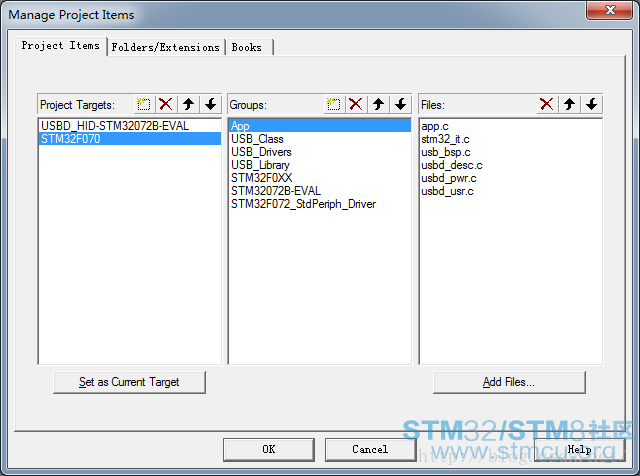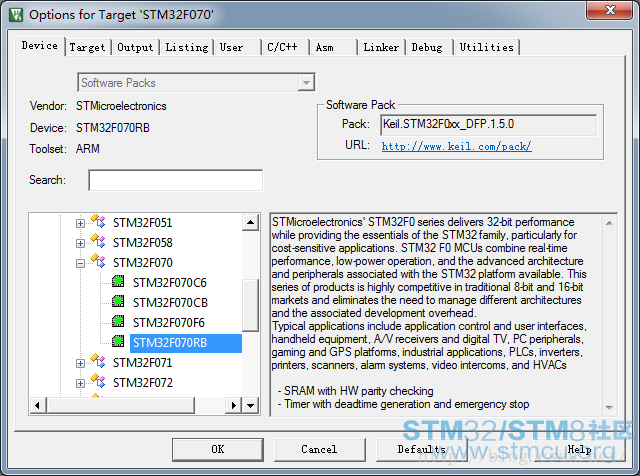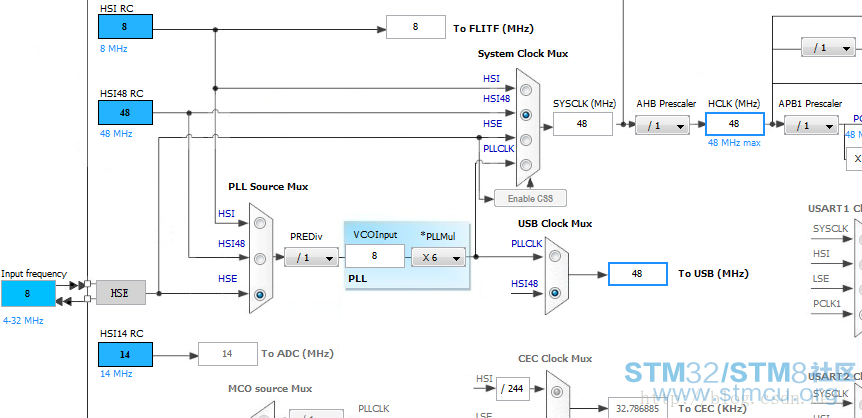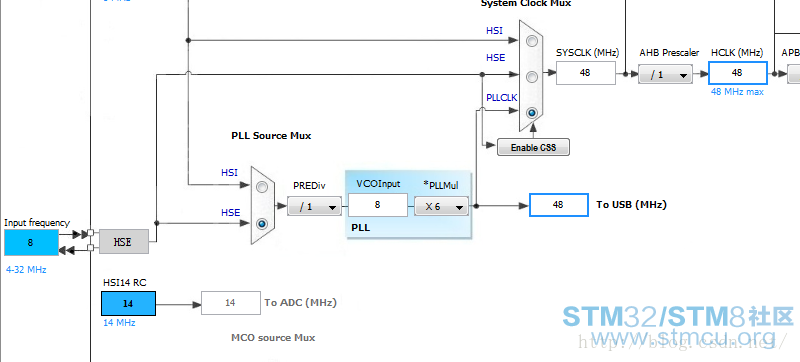1. 前言
ST官方提供的USB库STM32F0x2_USB-FS-Device_LibV1.0.0 是基于标准库的,适用于STM32F0x2系列MCU,但是对于STM32F070来说,就需要稍作修改,本文就一直到STM32F070作一个笔记。
2. 移植
从STM中文官网上下载STM32F0x2 USB库,地址:https://www.stmcu.org.cn/document/detail/index/id-214961。用MDK打开,首先在Manager Project Items下的Project Targets下新增一项 “STM32F070”:

然后切换到”STM32F070”这个Target: 。此后对所有工程属性的修改都会使用于“STM32F070”,而不再是原先的“USBD_HID-STM32072B-EVAL”了。
接下来修改device为STM32F070RB:

工程配置弄好了后,接下来我们来修改代码部分。
首先我们来编译一下工程,发现此时是可以编译通过的。但是烧录到STM32F070的板子里(这里使用ST的NUCLEO-F070RB板)去时却不能成功运行。
STM32F072与STM32F070这两个MCU都有USB,且此IP没有什么不同,那么差异是什么呢?
对比它俩的时钟树:

如上图是STM32F072的时钟树,可知STM32F072是有一个内部48M的晶振,这个晶振是专门给USB提供时钟的。

如上图是STM32F070的时钟树,对比STM32F072,发现STM32F070是没有那个48M内部晶振的,因此在给USB提供晶振时,需要使用到外部晶振,于是,在代码处找到设置晶振的代码进行修改:
usb_bsp.c 的USB_BSP_Init函数内:
- [cpp] view plain copy
- RCC_HSEConfig(RCC_HSE_Bypass);
-
- /* Wait till HSE is ready */
- while (RCC_GetFlagStatus(RCC_FLAG_HSERDY) == RESET)
- {}
-
- /*Config the PREDIV for RCC_CFGR2*/
- RCC_PREDIV1Config(RCC_PREDIV1_Div1);
- /*HSE/PREDIV selected as PLL input clock*/
- RCC_PLLConfig(RCC_PLLSource_PREDIV1,RCC_PLLMul_6);
- /* Enable PLL */
- RCC_PLLCmd(ENABLE);
-
- /* Wait till PLL is ready */
- while (RCC_GetFlagStatus(RCC_FLAG_PLLRDY) == RESET)
- {}
- /*use the PLLCLK as system input clock*/
- RCC_SYSCLKConfig(RCC_SYSCLKSource_PLLCLK);
- /* Wait till PLL is used as system clock source */
- while ((RCC->CFGR & (uint32_t)RCC_CFGR_SWS) != (uint32_t)RCC_CFGR_SWS_PLL)
- {
- }
- RCC_HCLKConfig(RCC_SYSCLK_Div1);
- RCC_PCLKConfig(RCC_HCLK_Div1);
- /* Configure USBCLK from PLL clock */
- RCC_USBCLKConfig(RCC_USBCLK_PLLCLK);
- [cpp] view plain copy
- //#include "stm32072b_eval.h"
- ...
- //#ifdef USE_STM32072B_EVAL
- /* When using STM32072B_EVAL board the internal pullup must be enabled */
- #define INTERNAL_PULLUP
- //#endif
- ...
- //#define USB_DEVICE_LOW_PWR_MGMT_SUPPORT //关掉低功耗管理
- ...
- //#define USB_CLOCK_SOURCE_CRS //STM32F070下是没有CRS的
- [cpp] view plain copy
- void SysTick_Handler(void)
- {
-
- #if 0
- uint8_t buf[4] ={0,10,10,0};
- USBD_HID_SendReport (&USB_Device_dev,
- buf,
- 4);
- #endif
- //#if 0
- // uint8_t *buf;
- //
- // /* Get Joystick position */
- // buf = USBD_HID_GetPos();
- //
- // /* Update the cursor position */
- // if((buf[1] != 0) ||(buf[2] != 0))
- // {
- // /* Send Report */
- // USBD_HID_SendReport (&USB_Device_dev,
- // buf,
- // 4);
- // }
- //#endif
- TimingDelay_Decrement();
- }
- [cpp] view plain copy
- void HAL_Delay(__IO uint32_t nTime)
- {
- TimingDelay = nTime;
-
- while(TimingDelay != 0);
- }
-
- /**
- * @brief Decrements the TimingDelay variable.
- * @param None
- * @retval None
- */
- void TimingDelay_Decrement(void)
- {
- if (TimingDelay != 0x00)
- {
- TimingDelay--;
- }
- }
在usbd_usr.c文件中的:
- [cpp] view plain copy
- void USBD_USR_Init(void)
- {
- /* SysTick used for periodic check mouse position */
- SysTick_Config(SystemCoreClock /1000);
- }
- [cpp] view plain copy
- int main(void)
- {
- uint8_t buf[4] ={0,10,10,0};
- /*!< At this stage the microcontroller clock setting is already configured,
- this is done through SystemInit() function which is called from startup
- file (startup_stm32f072.s) before to branch to application main.
- To reconfigure the default setting of SystemInit() function, refer to
- system_stm32f0xx.c file
- */
-
- /* The Application layer has only to call USBD_Init to
- initialize the USB low level driver, the USB device library, the USB clock
- ,pins and interrupt service routine (BSP) to start the Library*/
-
- USBD_Init(&USB_Device_dev,
- &USR_desc,
- &USBD_HID_cb,
- &USR_cb);
-
- while (1)
- {
- #if 1
- USBD_HID_SendReport (&USB_Device_dev,
- buf,
- 4);
- //delay
- HAL_Delay(1000);
- #endif
- }
- }
最后在NUCLEO板上测试OK!
转载自FLYDREAM0
|





 微信公众号
微信公众号
 手机版
手机版
